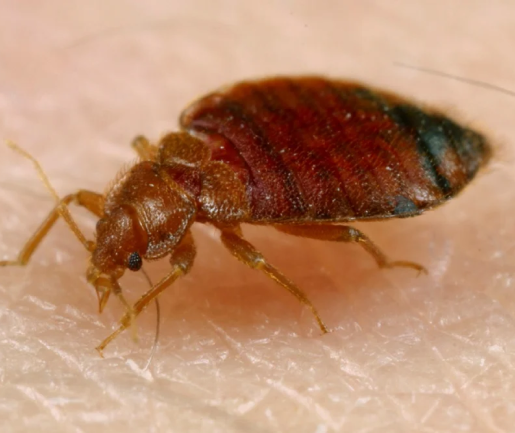Act Now - Limited Time Offer
$67 Pest Control

Ty Archer
Pest Control Technician
Chris Mosby
Pest Control Technician
Rob Adrain
Sales Representative
Known as Cimex lectularius, the bed bug is a small, reddish-brown insect that thrives on human blood. These bugs are roughly the size of an apple seed and typically hide in mattress seams, box springs, and the cracks of furniture. Bed bugs are active mostly at night and can hide in small fabric folds, electrical outlets, and picture frames.
Bed bugs go through five juvenile stages before becoming adults, each requiring a blood meal to progress. Female bed bugs can lay about five eggs a day in well-hidden places. They have the ability to live for several months without a meal. While bed bugs don’t transmit diseases, their bites can lead to itching and allergic reactions.


Cimex Hemipterus is a bed bug species common in tropical and subtropical areas. Like Cimex lectularius, it feeds on human and animal blood. These bugs are small, reddish-brown, and grow to about 4-5 mm. Their oval and flat bodies allow them to hide in small cracks and crevices.
Typically active at night, Cimex hemipterus can also feed during the day if the environment is too hot or dry. They favor living near moisture to ensure their larvae survive. To detect an infestation, check around your bed or other places people rest. Look for tiny red blood dots on bedding, brown fecal streaks, and shed skins as common signs.
Leptocimex Boueti, a species of bed bug, can cause significant discomfort if they infest your home. They mostly feed on humans at night but may become active during the day if it’s too hot or dry. These bugs prefer to live near water, ensuring their larvae have access to drinking water, although they are not aquatic creatures.
Adult Leptocimex Boueti are approximately the size of an apple seed, with a flat and oval body. They have a reddish-brown color that deepens after feeding. These bed bugs have long antennae and compound eyes that look like raspberries. Their bodies can expand significantly while feeding. If you suspect a bed bug infestation, immediate action is important. Loomis Pest Control can provide the necessary services to eliminate the pests and prevent them from returning.

The eggs laid by bed bugs are tiny, about the size of a pinhead, and usually measure around 1mm in length. Their pearl-white color makes them blend into light-colored environments, making them hard to spot. After five days, you might notice a tiny eye spot on these eggs.
Bed bugs prefer to lay eggs in hidden, safe spots close to where they feed. They commonly lay eggs in mattress seams, box spring crevices, and under baseboards. A female bed bug can lay up to five eggs a day, and these will hatch in 4-12 days. Untreated, these eggs can cause new infestations.


Nymphs are young bed bugs that go through five developmental phases before they become adults. These nymphs are smaller and lighter in color compared to adult bed bugs, making them harder to spot. They need a blood meal to molt to the next stage, which takes about 5-10 minutes.
They are commonly found near places where people sleep or relax, like in mattress seams, bed frames, and other small hiding spots. Evidence of nymphs includes small pale bugs and tiny blood spots on sheets. Proper treatment targets these areas to ensure complete eradication of nymphs.
Adult bed bugs are tiny, reddish-brown insects, similar in size to an apple seed. Their bodies are flat and oval, becoming more rounded after feeding. They feed on human blood, mostly biting at night while people sleep.
Bed bugs often hide in places close to sleeping people, such as mattress seams, box springs, bed frames, and nearby furniture. They can also be found behind outlets and in picture frames. Look for small red blood stains, dark brown fecal spots, and discarded skins as signs of infestation. Regularly checking these areas can help identify and manage bed bug problems early.

Loomis Pest Control begins bed bug treatment with a detailed inspection by our skilled inspectors. They identify bed bugs using photos or specific signs and issue a preparation sheet with necessary steps. Customers must prepare by removing wall hangings, vacuuming the infested areas, and washing bedding and clothing. Our technicians thoroughly treat the room, focusing on all furniture legs, moldings, cracks, crevices, bed frames, headboards, box springs, and mattresses. The fabric under the box spring should be removed for effective treatment. Post-treatment, the treated area should be vacant for at least three hours.
We suggest 3-4 treatment sessions, depending on how severe the infestation is. Costs are determined after the inspection. Our treatments are safe for pets, but we recommend vacating the premises for 3-4 hours during and after treatment. A 30-day warranty is provided for whole-home treatments. To prevent reinfestation, follow our instructions and maintain a clean environment. Our comprehensive and efficient methods ensure the complete eradication of bed bugs, providing our clients with comfort and peace of mind.


Two weeks following our initial bed bug treatment, we provide a complimentary follow-up service. This includes the use of an insect growth regulator to interrupt the life cycle of bed bugs, ensuring that any leftover eggs or nymphs are treated, preventing them from maturing.
Our technicians will conduct a thorough inspection of the treated areas to look for any remaining bed bug activity. This additional check provides an extra layer of protection and peace of mind. With our follow-up, you can trust that we are committed to ensuring your home is completely bed bug-free.

Serving Loomis and its nearby communities, we’re here to keep your spaces pest-free. Our team is passionate about these areas and always aims to deliver excellent service and proven results.
Limited time offer! Get $50 off your first pest control service.

Barrier Services
Loomis Office
© Loomis Pest Control 2024